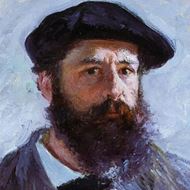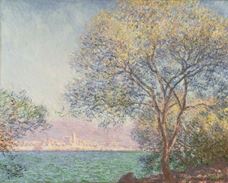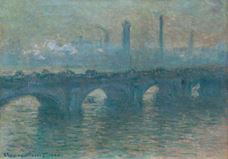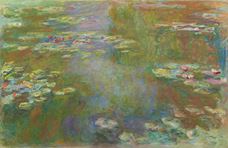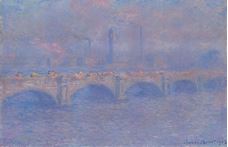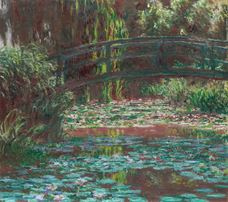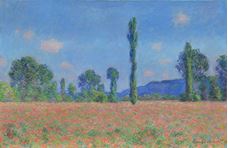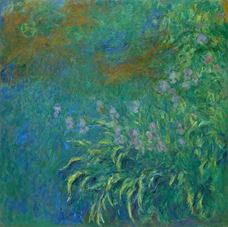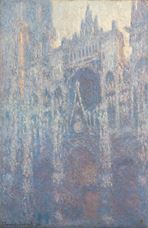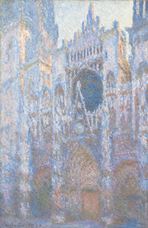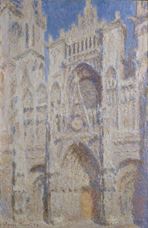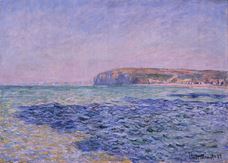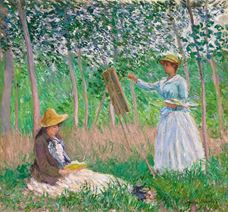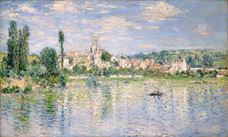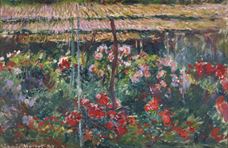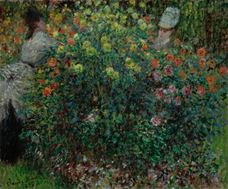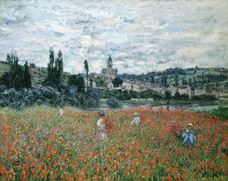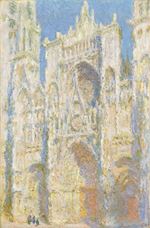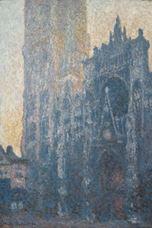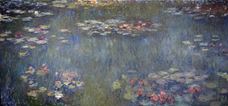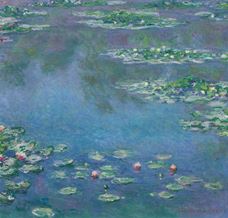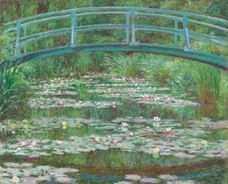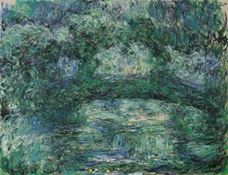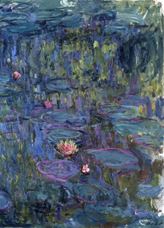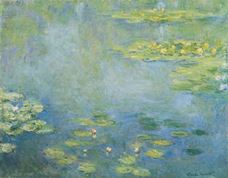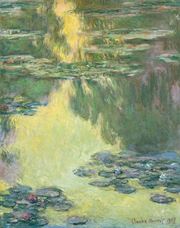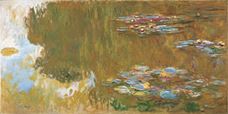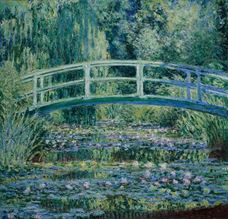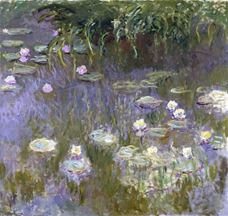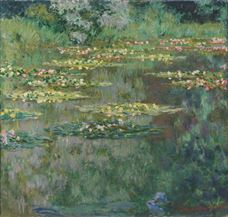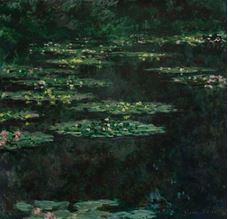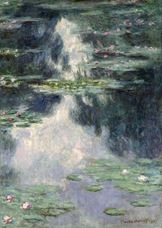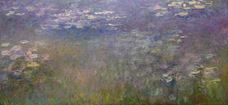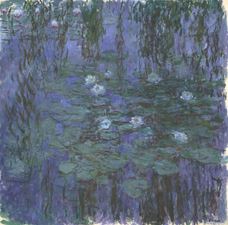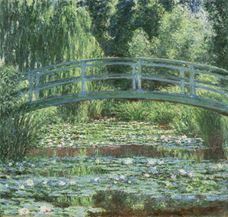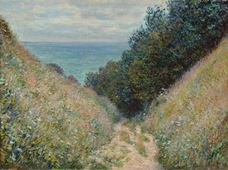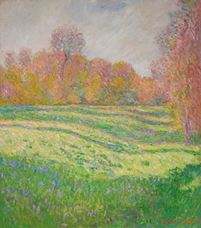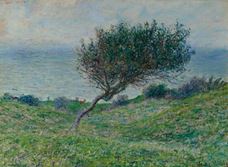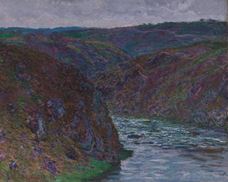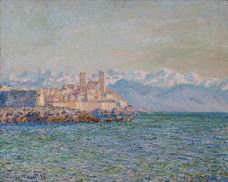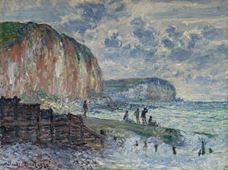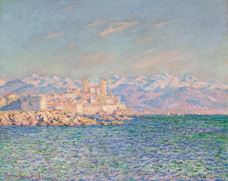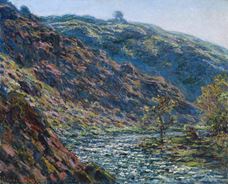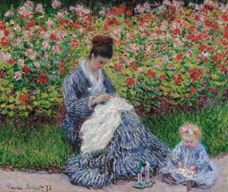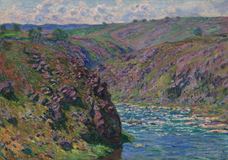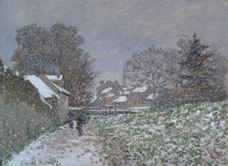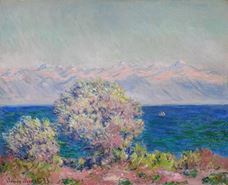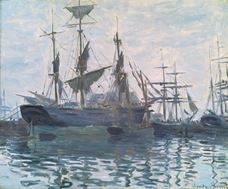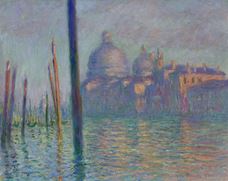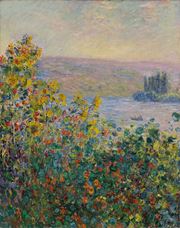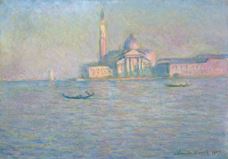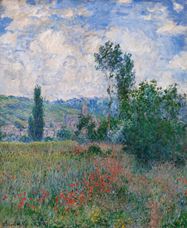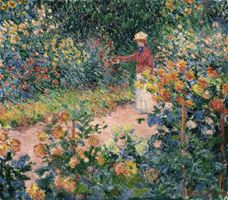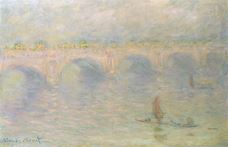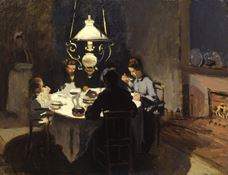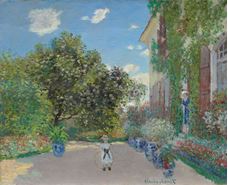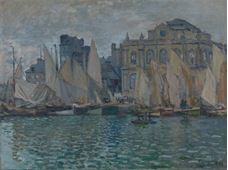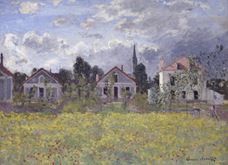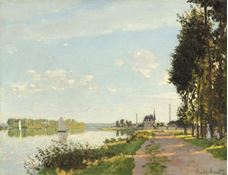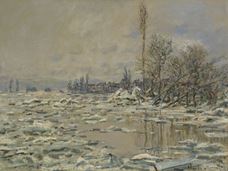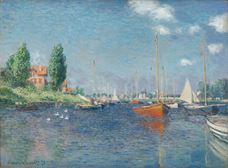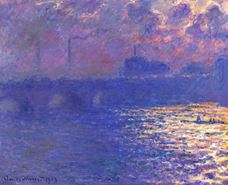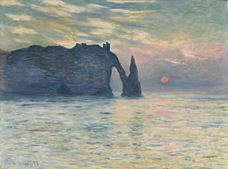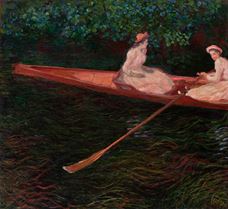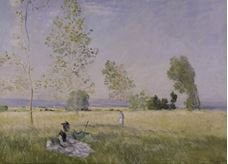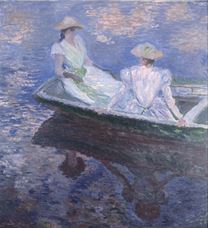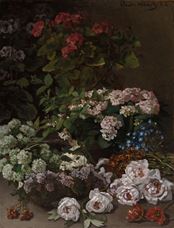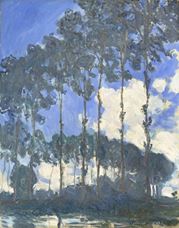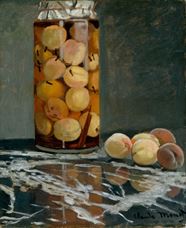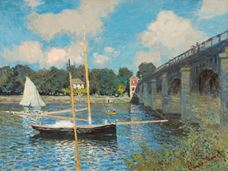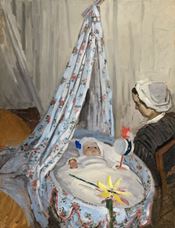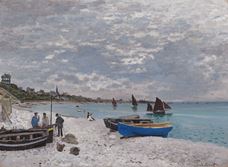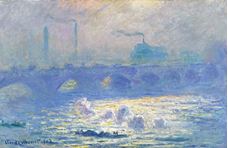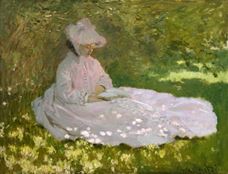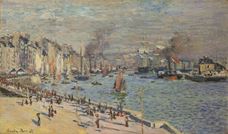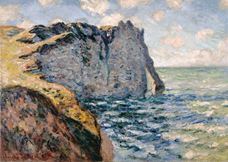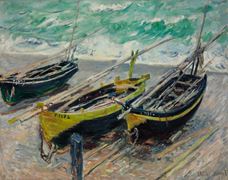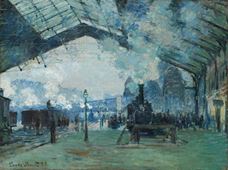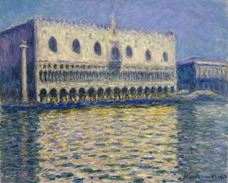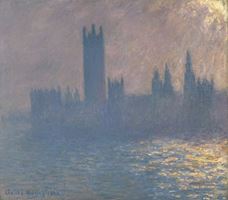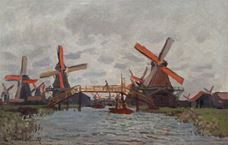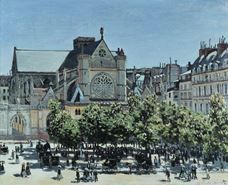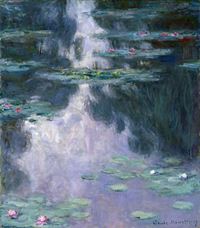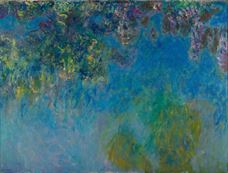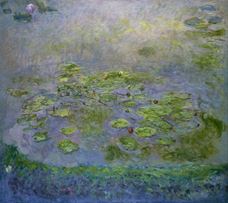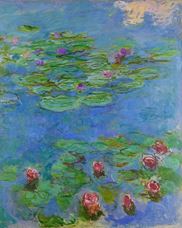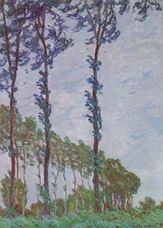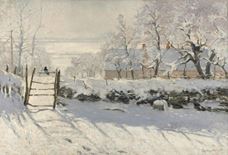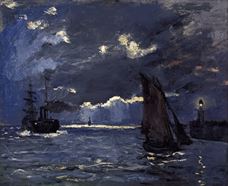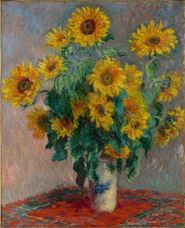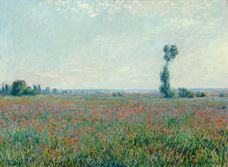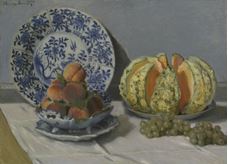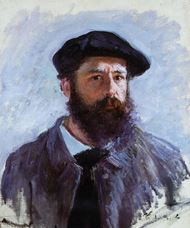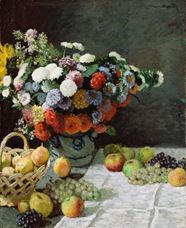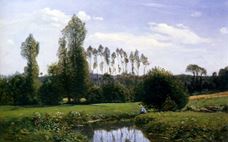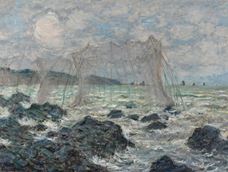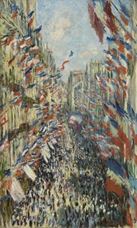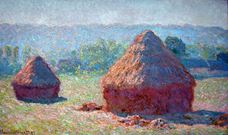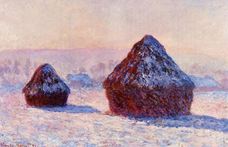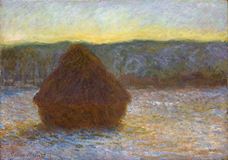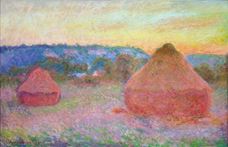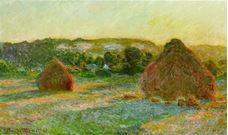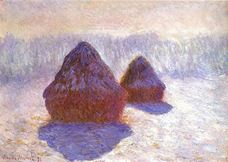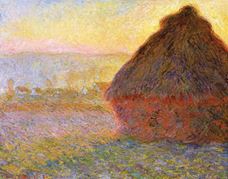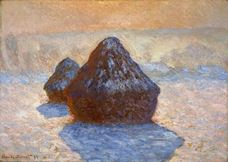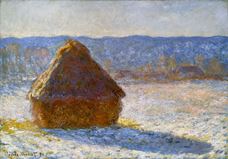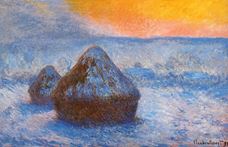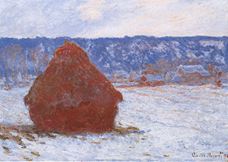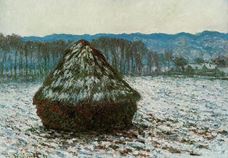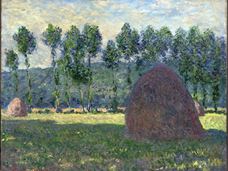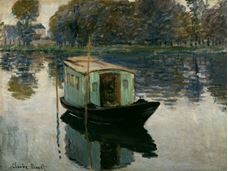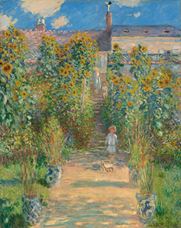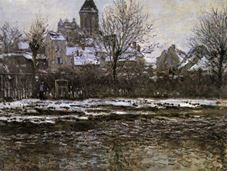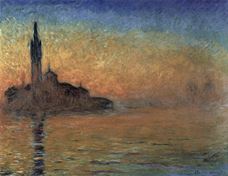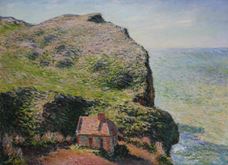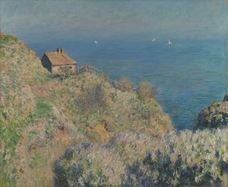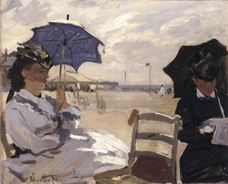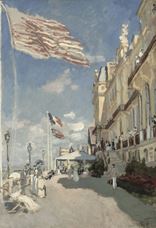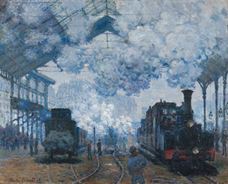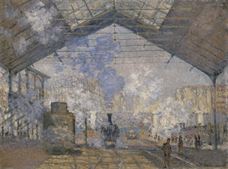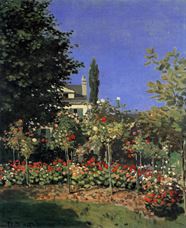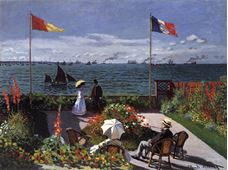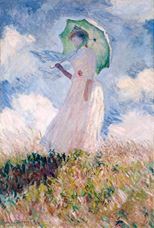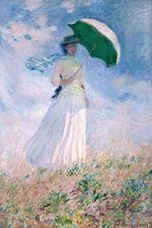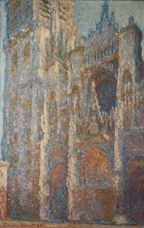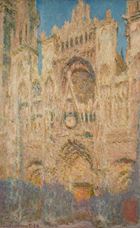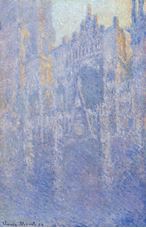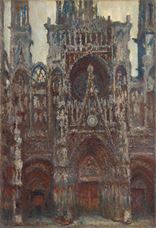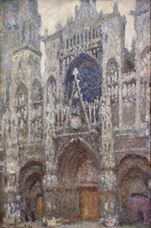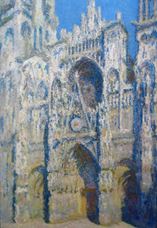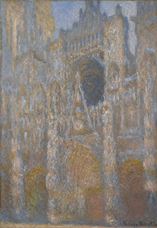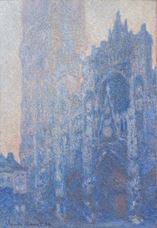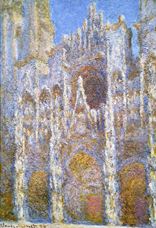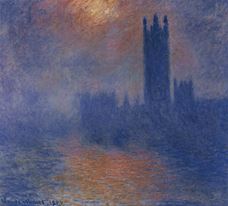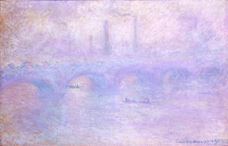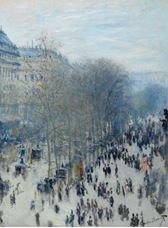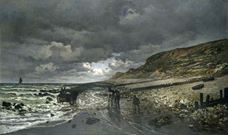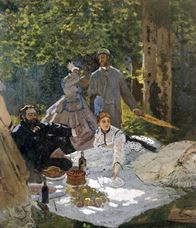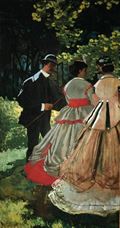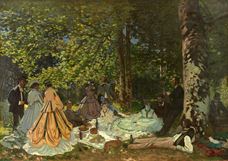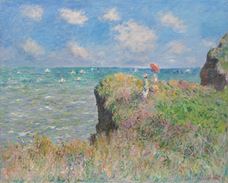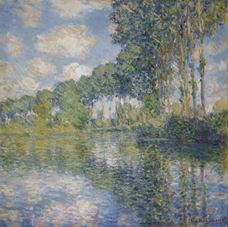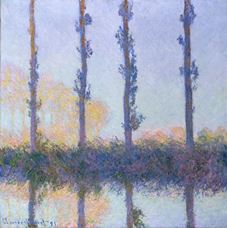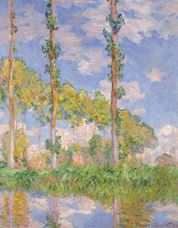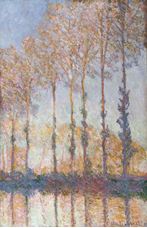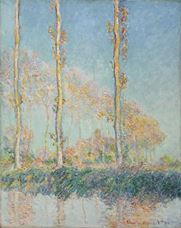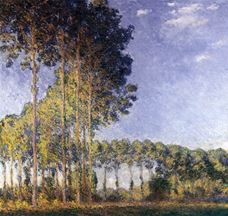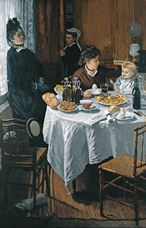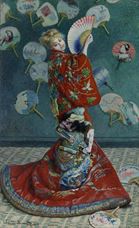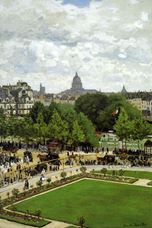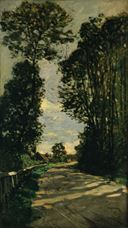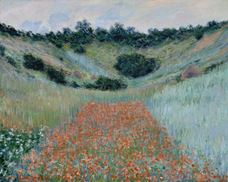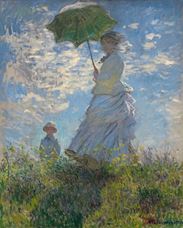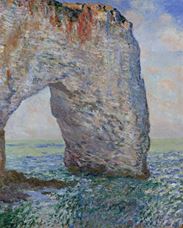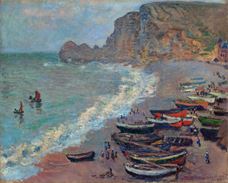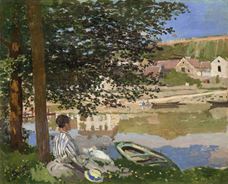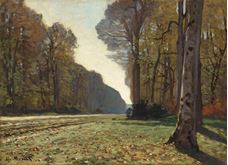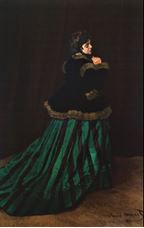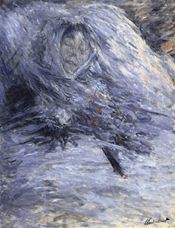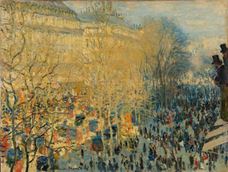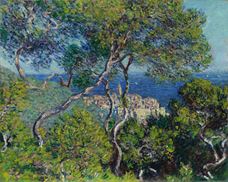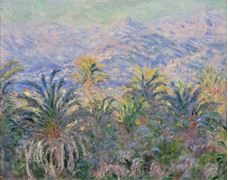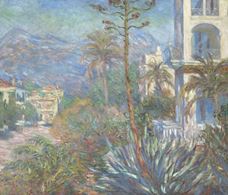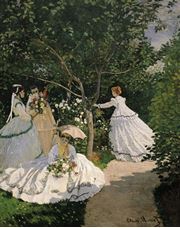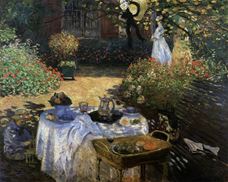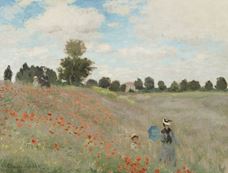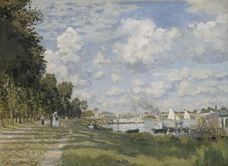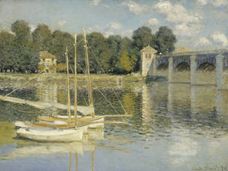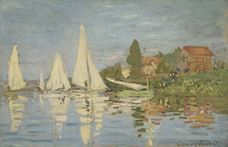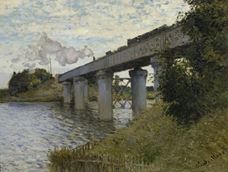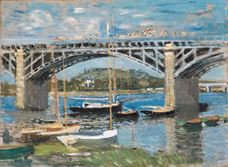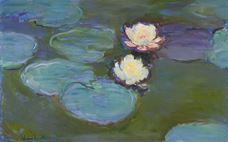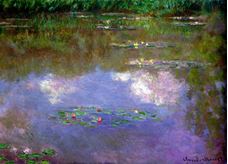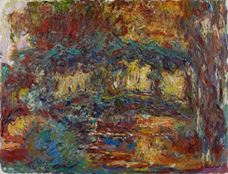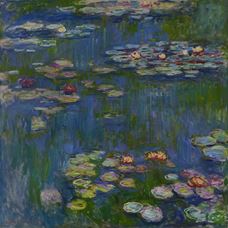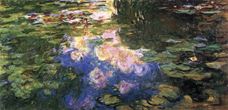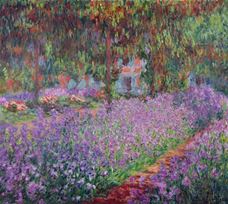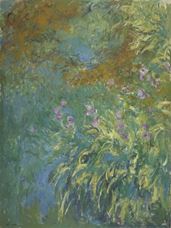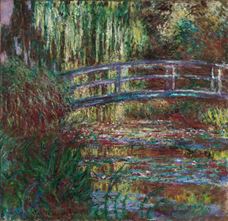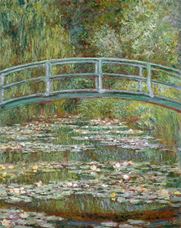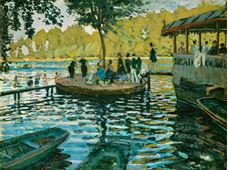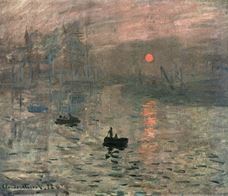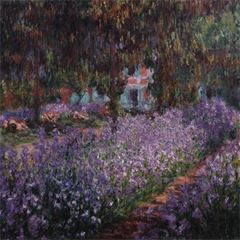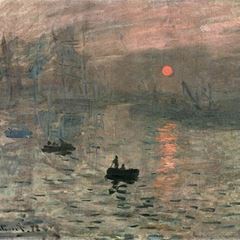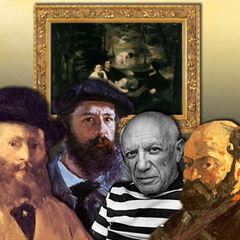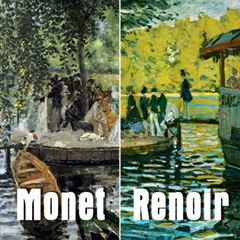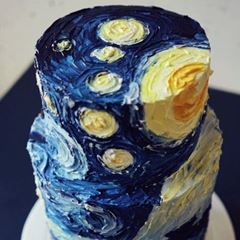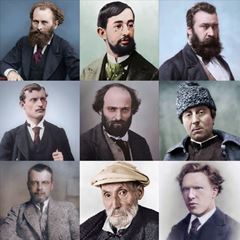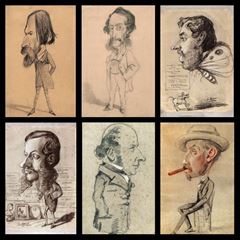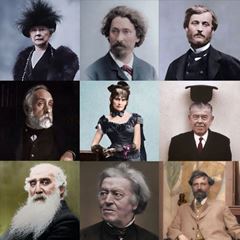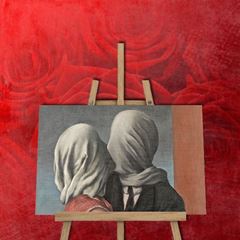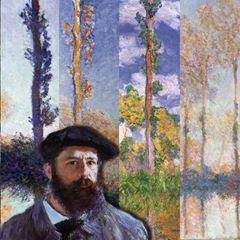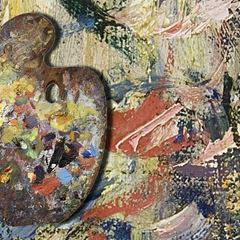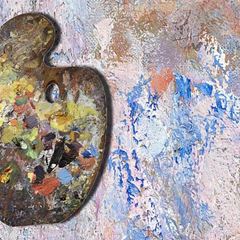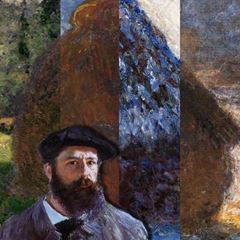Oscar-Claude Monet was born on November 14, 1840, in Paris, the second son of Claude-Adolph Monet and Louise-Justine Aubree. His father owned a small grocery store. when his father's job worsened, the family moved to Paris in 1845 from Le Havre. Monet started school here in 1851. Monet's art teacher was Francois Ochard, a master artist who was a student of Jacque-Louis David, famous for his historical paintings. Monet's predisposition to art appeared in the caricatures he drew. He became known in a short time with his teachers and the cartoons about the people of Le Havre. Outside the school, he continued his success and earned his first money from its cartoons.
In 1856 he met Eugene Boudin, a master painter who was known for his paintings of sea and coast in the open air. Boudin showed Monet the subtleties of painting outdoors. He supported Monet to continue his painting. Monet reflected Boudin's teachings to his own paintings, and in 1858 joined the exhibition in Le Havre with the painting "View at Rouelles". Monet decided to become a painter in these years. His mother, who would become a supporter of this decision, passed away in 1857. His father wanted him to continue his family business. But when he saw his son determined, he didn't stop him.
In 1859 Monet went to Paris to study painting. Here, he enrolled in a private painting school, the Suisse Academy. During his education, he met Camille Pissarro. Monet's academy period ended in 1861 with the call for conscription. He was sent to Algeria but returned to Le Havre because of his deteriorating health.
In 1862 he went to Paris and enrolled in the famous atelier of the painter Charles Gleyre. He met three young painters, Frédéric Bazille, Alfred Sisley and Auguste Renoir in the atelier. This quartet would form the core of the Impressionists. Monet and his friends were participating in art trips in Paris and were increasingly losing their interest in Gleyre's traditional art approach. In 1863, they left the atelier to paint in the open air in the forest of Fontainebleau. At the same time, Édouard Manet's painting “The Luncheon on the Grass” was exhibited in the Salon des Refuses, an alternative to the Paris Salon, and led to great controversy. In 1865, Monet designed a painting on the same theme, inspired by this painting. He wanted to make a six-meter-wide gigantic painting in the open air for "Lunch on the Grass". But it was a technically difficult project. Since there was little time left for the opening of the Salon, he had to prepare another picture. In 1866, he painted a full-length portrait of Camille Doncieux, his model and lover, with an elegant dress. This painting was accepted and brought Monet a big success. After the exhibition of painting, the names of Monet and Manet were mentioned together with the contribution of the critics and this duo met and became close friends.
Monet fell into economic hardship after his outdoor composition "Women in the Garden", which was painted in 1867, was rejected by the Salon jury. His family opposed living with Camille and didn't support Monet. To give the impression of leaving Camille for a while, he moved into his aunt's house in Saint-Adresse. He had a fertile period in Le Havre. "Garden at Sainte-Adresse" from the paintings of this period brought flowers and light together with water, which was the first subject of Monet.
In August 1867, Camille gave birth to her son Jean in Paris, and Monet spent more time in Paris. When he made sales for the sea fair in Le Havre, it was a short-term relief in Monet's material case in 1868. The young family moved to the coastal town of Etretat near Le Havre. He made pictures at Monet, Etretat, and Fécamp. In the summer of 1869, Monet and his family moved to Saint-Michel near Bougival on the west coast of Seine. Renoir often visited Monet, they worked together in landscape paintings. The nearby La Grenouillère was a favorite meeting place for those coming from Paris. Monet and Renoir transferred this place in Bougival to the canvas.
In 1870, Monet and Camille were married. Just before the French-Prussian War, which would soon break out, they went to Trouville on the Normandy coast and then to London. In London, Monet met Paul Durand-Ruel, who came from Paris and bought and sold artworks. For many years he would sell a large part of the artist's works. Several views of the Thames and London parks were the main works of this period.
Zaandam, a small city near Amsterdam, was one of the places where Monet visited. The main themes of his art here, the sky and water, were in an ideal combination. He painted images outdoors using soil colors.
He returned to France in 1871 and moved with his family to a garden house in Argenteuil, northeast of Paris. With the legacy he left after his father's death, he was able to lead a better life with the support of Paul Durand-Ruel. Renoir, Pissarro, and Manet hosted his friends in his house. Monet, where he became interested in water. He built a cabin in a large boat and added a sunshade to protect himself from the sun. He created a floating studio. This studio boat was featured in a few paintings of him. He made cruises on the water with his easel and depicted water landscapes. Manet painted this boat in 1874 and he would describe the artist as he painted. During his six years in Argenteuil, Monet painted many pictures of the river Seine and the countryside near his home. Monet did more than one hundred works here. These studies, which were made with bright and light colors and were used in light and fast painting techniques, would be considered among the most beautiful and well-known works of impressionism.
In late 1873, a group of painters, including Monet, Renoir, Cézanne, Sisley, and Pissarro, gathered together. They decided to open an exhibition organized and financed by them. This artist organization opened its first exhibition in Boulevard des Capucines in April 1874 in the studio of photographer Nadar for one month. Boulevard des CapucinesMonet's "Impression, Sunrise", which he painted in Le Havre in 1872, and "Boulevard des Capucines" in 1873, two of the masterpieces of the period were among the exhibitions. Even though the views of the critics on the exhibition are divided into two, the name of the new picture movement came from this exhibition. The art critic Louis Leroy wrote the most serious critique of the exhibition. He named the painting of Monet's "Impression, Sunrise" in the style of the whole group. Leroy called his critique "the Exhibition of Impressionists." Thus, the name of Impressionism was also established.
In 1876, his store manager, Ernest Hoschedé, gave Monet the job of making ornamental boards in a room of his house. But he went bankrupt the following year. Monet would continue friends with Hoschedé and his wife Alice. After a short period of spend in Paris, Monet and his family moved to Vetheuil in 1878. Their second son, Michel, was born in Paris. The Hoschedés, who drew the flag of bankruptcy, joined them with their six children. Alice, with six of her children, also took care of Monet's two sons, so the two families united. In 1879, when Camille died at the age of 32, Monet painted him on his deathbed. In this unhappy and difficult period, the artist made nearly 200 landscapes with a focus of uncontaminated nature. People were rarely seen in his paintings, and they were only seen as details integrated with nature. After Camille died, Alice Hoschedé became a loyal friend for Monet. When Alice's husband Ernest Hoshedé left the house, Monet took charge of eight children. In 1881, Monet moved once again with Alice Hoschedé and her children and settled in Poissy, a small town about twenty kilometers outside of Paris. He could easily do long journeys to the coasts of Normandy he admired.
1882 was a productive year for Monet. He traveled to the coasts of Normandy many times and, in different respects, made the "The Customs Officer's Cottage at Varengeville" at different times of the day. He painted sea views from Pourville near Dieppe. In 1883 he went to Etretat, famous for its strange coastal formations. These coastal paintings were the first signs of Monet's work towards series work. In the same year, he rented a house in Giverny in the west of Paris and moved there with his large family. This would be the last transport of Monet. At the end of the year, he traveled to South France with his painter friend Renoir. After this trip, in 1884, Monet settled in Bordighera, a small town on the Italian Riviera. He made his most colorful paintings here. He depicted the sea, the sky, the twisting of the branches of the pine trees under the bright sun. In lemon groves, olive trees, and palm trees, turquoise, bright sea blue, pink, orange as he used colors that were almost never mentioned before in his palette.
In 1886, he painted the giant rock arch known as Manneporte in Etretat, with pictures depicting the rock formation on the coast of Belle-île-en-Mer, a small island off the south coast of Britain. Around here, he chose the bare rocks, the sea as the subject. He looked for the changing glow of the sky, the changes of colors in the light. He almost didn't give any place to people in his paintings. If he used the figure in his paintings, it was because he brought a sense of depth to the landscape of the figures. From the year 1886 on the shores of Belle-île-en-Mer, he began to focus on a scene by painting various variations of the same perspective. His work received positive reviews. In 1888 he traveled to Côte d'Azur and worked similarly in Antibes. In 1890-1891, haystacks and poplar trees along the Epte coast; in 1892-1894, he produced a series of pictures depicting the western façade of Rouen Cathedral. He won extraordinary success with pictures of this series he did.
Monet had financial security because he was able to sell his paintings on a regular basis. in 1890, Since 1883, he had been able to buy the house, where they had been sitting in Giverny. In 1892, after the death of Ernest Hoschedé, Monet and Alice Hoschedé got married. Monet, who bought the land in Giverny, began to reorganize the garden. He converted it into a water garden, the area separated by rail from the garden and using the river passing through it.
In 1895, he built an arched bridge like the ones on Japanese wooden prints. Thoughtfully placed plants and the lotus pool inspired the creation of numerous garden pictures even if he left for a short trip, Giverny was increasingly a reference point for Monet. In 1895 he made a short trip to Norway. In the fall of 1899, he went to London with Alice. Here he made the Thames series, which included paintings such as "Parliament Buildings", "London and Waterloo Bridge in Misty Weather". In 1908, he went to Venice. Here he created the Venetian series, where he showed stonework and the massive and varied contrast of water. After a trip to Venice, Monet's eyes revealed cataract disease that caused loss of vision and color perception. This metamorphosis in his eyes was reflected in the works of that period.
In 1911, Monet became depressed with the death of Alice Monet. And his eyes got worse. After two surgeries in 1923, his eyes became healthy and he continued painting. In the last thirty years of his life, the water garden was the main subject of Monet's painting. The landscapes in which the water world consisting of reflections were depicted reached the peak with giant water lily paintings that continued until his death. Monet died of lung cancer in Giverny on December 5, 1926, at the age of 86.
Bibliography;
Heinrich, C., (2006). Monet, Birinci Basım, Taschen/Remzi Kitabevi, İstanbul.
Zeidler, B., (2005). Monet, Literatür Yayıncılık, İstanbul.
Altuna, S., (2013). Ünlü Ressamlar Hayatları ve Eserleri, Birinci Baskı, Hayalperest Yayınevi, İstanbul.
Newall, D., (2014). Empresyonistler Ayrıntıda Sanat, İkinci Basım, Türkiye İş Bankası Kültür Yayınları, İstanbul.
Lunday, E., (2013). Büyük Sanatçıların Gizli Hayatları, Beşinci Baskı, Domingo Yayınevi, İstanbul.
Spence, D., (2012). Büyük Ressamlar Monet, Üçüncü Basım, Koleksiyon Yayıncılık, İstanbul.
Bell, J., (2009). Sanatın Yeni Tarihi, Birinci Baskı, NTV Yayınları, İstanbul.
Turani, A., (2010). Dünya Sanat Tarihi, On Dördüncü Baskı, Remzi Kitabevi, İstanbul.
Şenyapılı, Ö., (2003). Ressamlar ve Kadınları, Odtü Geliştirme Vakfı Yayıncılık ve İletişim A.Ş. Yayınları, Ankara.
Güvemli, S., (2005). Sanat Tarihi, Dördüncü Baskı, Varlık Yayınları, İstanbul.
1840 He was born on 14 November in Paris.
1845 He moved with his family to Le Havre.
1851 He started school in Le Havre.
1856 He met the painter Eugene Boudin.
1857 Monet's mother passed away.
1859 He went to Paris to study painting and enrolled in the Suisse Academy. He met Camille Pissarro.
1861 He was called to military service and sent to Algeria.
1862 He returned to Paris. He entered the workshop of Charles Gleyre (1806 -1874). Here he met with Auguste Renoir (1841-1919), Alfred Sisley (1839 -1899), and Frédéric Bazille (1841-1870).
1863 Monet and his friends painted in the Fontainbleau Forest. They left Charles Gleyre's workshop at the end of the year.
1865 Monet began to work on the "The Luncheon on the Grass" in very large sizes for the "Salon" exhibition.
1866 "Woman in Green Dress" ’was exhibited at the "Salon" and gained great success.
1867 He moved into his aunt's house in Saint-Adresse. Camille Doncieux gave birth to his son Jean.
1868 He was awarded a silver medal at the exhibition in Le Havre. Moved to Etretat.
1869 Monet, together with Renoir he made the painting ”La Grenouillère".
1870 Monet married Camille Doncieux. He made sea views in Trouville. He went to London. There he met the art dealer Paul Durand-Ruel of Paris.
1871 Monet's father passed away. In autumn he returned to France through the Netherlands. The family settled in Argenteuil.
1872 Monet build a floating workshop. He described the Seine coast. He made "Impression, Sunrise" in Le Havre.
1873 Monet, leading impressionist artists Société Anonyme Cooperative des Artistes, Peintres, Sculpteurs, Graveurs, etc. founded a company with the name. They started organizing collective exhibitions.
1874 An exhibition of the first Impressionist community was organized.
1877 Monet painted the "Saint-Lazare Train Station".
1878 Monet 's second son, Michel, was born in Paris. Moved to Vétheuil. Alice Hoschedé came with six children.
1879 He made snow paints in Vétheuil. On September 5, Camille died at age 32. Monet painted him on his deathbed.
1880 Monet's first and only exhibition was successful.
1881 Monet moves to Poissy with Alice Hoschedé and her children.
1883 He traveled to Etretat. Moved to Giverny. He went to South France with Renoir.
1884 He went to the Italian Riviera.
1886 He worked in Etretat and Brittany. He met Gustave Geffroy in Brittany. Gustave Geffroy later wrote on Monet's life story.
1890 Monet worked on the "Haystack" series and began the series "Poplar". Giverny'ta sitting since 1883 bought the house.
1892 He worked on the series "Rouen Cathedral". Alice Hoschedé married with Monet.
1895 He went to Norway.
1899 Monet began the series "Water Lilies" in the water gardens of Giverny. She went to London in the fall. "The Thames and the Parliament" made a series of paints.
1908 Monet 's seeing decreased. He went to Venice with Alice.
1911 Alice Hoschedé passed away on 19 May.
1912 Monet's eyes worsened, and the ophthalmologist diagnosed cataracts.
1914 Monet's eldest son, Jean is dead. Monet began making giant water lilies as a mural. France entered the First World War on 3 August.
1915 Monet established a new workshop for the paintings of "water lilies".
1918 A ceasefire was announced on 11 November. Eight paintings from the water lilies donated to the state in honor of the Armistice Agreement.
1923 Monet's eyes became healthy through two operations; returned to painting. He continued to work on the great lotus ornaments.
1926 Claude Oscar Monet, died on December 6 at the age of 86 in Giverny.













